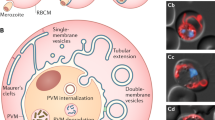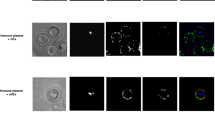Abstract
IN a previous communication1 it was reported, that the antimalarial drug, chloroquine, becomes highly concentrated in red blood cells containing the malarial parasite, Plasmodium berghei, through a mechanism of uptake which appears qualitatively distinct from that of uninfected red blood cells, plasma and host tissues. It was suggested that the ability of chloroquine to become selectively concentrated in the infected red cell constitutes the essential basis of its antimalarial activity. Because red blood cells parasitized by a strain of P. berghei resistant to chloroquine absorbed less than half the amount taken up by erythrocytes infected with the chloroquine-sensitive parent strain, the phenomenon of selective drug uptake may in part account for drug resistance. We report here observations on the sequential morphological changes produced by chloroquine in P. berghei in mice. Use of the same experimental model allows us to correlate changes in the structure of the parasite with changes in drug concentration in the parasitized red cell and suggests a mechanism by which the drug becomes concentrated in the parasite.
This is a preview of subscription content, access via your institution
Access options
Subscribe to this journal
Receive 51 print issues and online access
$199.00 per year
only $3.90 per issue
Buy this article
- Purchase on Springer Link
- Instant access to full article PDF
Prices may be subject to local taxes which are calculated during checkout
Similar content being viewed by others
References
Macomber, P. B., O'Brien, R. L., and Hahn, F. E., Science, 152, 1374 (1966).
Thurston, J. P., Trans. Roy. Soc. Trop. Med. Hyg., 44, 703 (1951).
Macomber, P. B., Tousimis, A. J., and Sprinz, H., J. App. Phys., 35, 3088 (1964).
Rudzinska, M. A., and Trager, W., J. Biophys. Biochem. Cytol., 6, 103 (1959).
Pathology symposium—Lysosomes, Fed. Proc., 23, 1009 (1964).
Warhurst, D. C., and Hockley, D. J., preceding communication.
Peters, W., Fletcher, K. A., and Staubli, W., Ann. Trop. Med. Parasitol., 59, 126 (1965).
Aikawa, M., Hepler, P. K., Huff, C. G., and Sprinz, H., J. Cell Biol., 28, 355 (1966).
Hahn, F. E., O'Brien, R. L., Ciak, J., Allison, J. L., and Olenick, J. G., Military Medicine, 131 (Suppl.), 1071 (1966).
Mackerras, M. J., and Ercole, Q. N., Trans. Roy. Soc. Trop. Med. Hyg., 42, 443 (1949).
Schueler, F. W., and Cantrell, W. F., J. Pharm. Exp. Therap., 143, 278 (1964).
Cohen, S. N., Phifer, K. O., and Yielding, K. L., Nature, 202, 805 (1964).
Peters, W., Nature, 203, 1290 (1964).
Jacobs, R. L., J. Parasitol., 51, 481 (1965).
Thompson, P., Science, 148, 1240 (1965).
Author information
Authors and Affiliations
Rights and permissions
About this article
Cite this article
MACOMBER, P., SPRINZ, H. & TOUSIMIS, A. Morphological Effects of Chloroquine on Plasmodium berghei in Mice. Nature 214, 937–939 (1967). https://doi.org/10.1038/214937a0
Issue Date:
DOI: https://doi.org/10.1038/214937a0
This article is cited by
-
Validation of a chloroquine-induced cell death mechanism for clinical use against malaria
Cell Death & Disease (2014)
-
Hemozoin Biocrystallization in Plasmodium falciparum and the antimalarial activity of crystallization inhibitors
Parasitology Research (2007)
-
Hemoglobin catabolism and the killing of intraerythrocyticPlasmodium falciparum by chloroquine
Experientia (1994)
-
Changes caused by chloroquine in cultured nervous tissues of the rat
Acta Neuropathologica (1975)
Comments
By submitting a comment you agree to abide by our Terms and Community Guidelines. If you find something abusive or that does not comply with our terms or guidelines please flag it as inappropriate.



